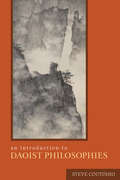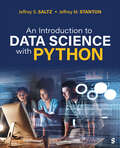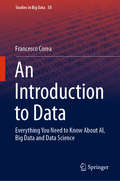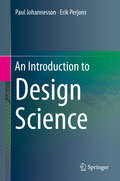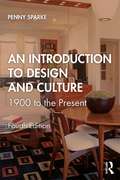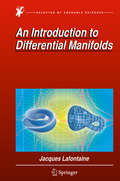- Table View
- List View
An Introduction to Daoist Philosophies
by Steve CoutinhoSteve Coutinho explores in detail the fundamental concepts of Daoist thought as represented in three early texts: the Laozi, the Zhuangzi, and the Liezi. Readers interested in philosophy yet unfamiliar with Daoism will gain a comprehensive understanding of these works from this analysis, and readers fascinated by ancient China who also wish to grasp its philosophical foundations will appreciate the clarity and depth of Coutinho's explanations.Coutinho writes a volume for all readers, whether or not they have a background in philosophy or Chinese studies. A work of comparative philosophy, this volume also integrates the concepts and methods of contemporary philosophical discourse into a discussion of early Chinese thought. The resulting dialogue relates ancient Chinese thought to contemporary philosophical issues and uses modern Western ideas and approaches to throw new interpretive light on classical texts. Rather than function as historical curiosities, these works act as living philosophies in conversation with contemporary thought and experience. Coutinho respects the multiplicity of Daoist philosophies while also revealing a distinctive philosophical sensibility, and he provides clear explanations of these complex texts without resorting to oversimplification.
An Introduction to Daoist Thought: Action, Language, and Ethics in Zhuangzi
by Eske MøllgaardThis is the first work available in English which addresses Zhuangzi’s thought as a whole. It presents an interpretation of the Zhuangzi, a book in thirty-three chapters that is the most important collection of Daoist texts in early China. The author introduces a complex reading that shows the unity of Zhuangzi’s thought, in particular in his views of action, language, and ethics. By addressing methodological questions that arise in reading Zhuangzi, a hermeneutics is developed which makes understanding Zhuangzi’s religious thought possible. A theoretical contribution to comparative philosophy and the cross-cultural study of religious traditions, the book serves as an introduction to Daoism for graduate students in religion, philosophy, and East Asian Studies.
An Introduction to Data Analysis Using IBM SPSS
by Lokesh JasraiThis textbook elaborates on the basic understanding and application of statistical tests and data analysis using hypothetical datasets and SPSS version 22.0. It presents step-by-step processes and to-the-point interpretation for quick assimilation and comprehension.Data Analysis Using SPSS Begins with the stages of data entry and goes on till editing and data visualization. Takes the readers through descriptive statistics, frequency, univariate, bivariate and regression analysis, cross-tabulation, linear models and non-parametric test procedures. Presents information through dialog boxes and tabular charts, and also incorporates important formulae, calculations and illustrations of sample data for an in-depth understanding of concepts and results. Can be used as a textbook as well as a reference book as it helps to build conceptual understanding, gaining software skills, and communicates data and its insights to accomplish research assignments, research/capstone projects and PhD research work. With comprehensive coverage, this book would be useful to the students, researchers and teachers of the various social sciences disciplines like Psychology, Sociology, Education, Social Work, Agriculture Management and other allied subjects. It would also be an invaluable companion to professionals and data scientists working in the field of analytics.
An Introduction to Data Analysis in R: Hands-on Coding, Data Mining, Visualization and Statistics from Scratch (Use R!)
by Alfonso Zamora Saiz Carlos Quesada González Lluís Hurtado Gil Diego Mondéjar RuizThis textbook offers an easy-to-follow, practical guide to modern data analysis using the programming language R. The chapters cover topics such as the fundamentals of programming in R, data collection and preprocessing, including web scraping, data visualization, and statistical methods, including multivariate analysis, and feature exercises at the end of each section. The text requires only basic statistics skills, as it strikes a balance between statistical and mathematical understanding and implementation in R, with a special emphasis on reproducible examples and real-world applications. This textbook is primarily intended for undergraduate students of mathematics, statistics, physics, economics, finance and business who are pursuing a career in data analytics. It will be equally valuable for master students of data science and industry professionals who want to conduct data analyses.
An Introduction to Data Analysis using Aggregation Functions in R
by Simon JamesThis textbook helps future data analysts comprehend aggregation function theory and methods in an accessible way, focusing on a fundamental understanding of the data and summarization tools. Offering a broad overview of recent trends in aggregation research, it complements any study in statistical or machine learning techniques. Readers will learn how to program key functions in R without obtaining an extensive programming background. Sections of the textbook cover background information and context, aggregating data with averaging functions, power means, and weighted averages including the Borda count. It explains how to transform data using normalization or scaling and standardization, as well as log, polynomial, and rank transforms. The section on averaging with interaction introduces OWS functions and the Choquet integral, simple functions that allow the handling of non-independent inputs. The final chapters examine software analysis with an emphasis on parameter identification rather than technical aspects. This textbook is designed for students studying computer science or business who are interested in tools for summarizing and interpreting data, without requiring a strong mathematical background. It is also suitable for those working on sophisticated data science techniques who seek a better conception of fundamental data aggregation. Solutions to the practice questions are included in the textbook.
An Introduction to Data Analysis: Quantitative, Qualitative and Mixed Methods
by Tiffany BerginCovering the general process of data analysis to finding, collecting, organizing, and presenting data, this book offers a complete introduction to the fundamentals of data analysis. Using real-world case studies as illustrations, it helps readers understand theories behind and develop techniques for conducting quantitative, qualitative, and mixed methods data analysis. With an easy-to-follow organization and clear, jargon-free language, it helps readers not only become proficient data analysts, but also develop the critical thinking skills necessary to assess analyses presented by others in both academic research and the popular media. It includes advice on: - Data analysis frameworks - Validity and credibility of data - Sampling techniques - Data management - The big data phenomenon - Data visualisation - Effective data communication Whether you are new to data analysis or looking for a quick-reference guide to key principles of the process, this book will help you uncover nuances, complexities, patterns, and relationships among all types of data.
An Introduction to Data Analysis: Quantitative, Qualitative and Mixed Methods
by Tiffany BerginCovering the general process of data analysis to finding, collecting, organizing, and presenting data, this book offers a complete introduction to the fundamentals of data analysis. Using real-world case studies as illustrations, it helps readers understand theories behind and develop techniques for conducting quantitative, qualitative, and mixed methods data analysis. With an easy-to-follow organization and clear, jargon-free language, it helps readers not only become proficient data analysts, but also develop the critical thinking skills necessary to assess analyses presented by others in both academic research and the popular media. It includes advice on: - Data analysis frameworks - Validity and credibility of data - Sampling techniques - Data management - The big data phenomenon - Data visualisation - Effective data communication Whether you are new to data analysis or looking for a quick-reference guide to key principles of the process, this book will help you uncover nuances, complexities, patterns, and relationships among all types of data.
An Introduction to Data Science
by Jeffrey S. Saltz Jeffrey Morgan StantonAn Introduction to Data Science is an easy-to-read, gentle introduction for advanced undergraduate, certificate, and graduate students coming from a wide range of backgrounds into the world of data science. After introducing the basic concepts of data science, the book builds on these foundations to explain data science techniques using the R programming language and RStudio® from the ground up. Short chapters allow instructors to group concepts together for a semester course and provide students with manageable amounts of information for each concept. By taking students systematically through the R programming environment, the book takes the fear out of data science and familiarizes students with the environment so they can be successful when performing advanced functions. The authors cover statistics from a conceptual standpoint, focusing on how to use and interpret statistics, rather than the math behind the statistics. This text then demonstrates how to use data effectively and efficiently to construct models, predict outcomes, visualize data, and make decisions. Accompanying digital resources provide code and datasets for instructors and learners to perform a wide range of data science tasks.
An Introduction to Data Science
by Jeffrey S. Saltz Jeffrey Morgan StantonAn Introduction to Data Science is an easy-to-read, gentle introduction for advanced undergraduate, certificate, and graduate students coming from a wide range of backgrounds into the world of data science. After introducing the basic concepts of data science, the book builds on these foundations to explain data science techniques using the R programming language and RStudio® from the ground up. Short chapters allow instructors to group concepts together for a semester course and provide students with manageable amounts of information for each concept. By taking students systematically through the R programming environment, the book takes the fear out of data science and familiarizes students with the environment so they can be successful when performing advanced functions. The authors cover statistics from a conceptual standpoint, focusing on how to use and interpret statistics, rather than the math behind the statistics. This text then demonstrates how to use data effectively and efficiently to construct models, predict outcomes, visualize data, and make decisions. Accompanying digital resources provide code and datasets for instructors and learners to perform a wide range of data science tasks.
An Introduction to Data Science With Python
by Jeffrey S. Saltz Jeffrey Morgan StantonAn Introduction to Data Science with Python by Jeffrey S. Saltz and Jeffery M. Stanton provides readers who are new to Python and data science with a step-by-step walkthrough of the tools and techniques used to analyze data and generate predictive models. After introducing the basic concepts of data science, the book builds on these foundations to explain data science techniques using Python-based Jupyter Notebooks. The techniques include making tables and data frames, computing statistics, managing data, creating data visualizations, and building machine learning models. Each chapter breaks down the process into simple steps and components so students with no more than a high school algebra background will still find the concepts and code intelligible. Explanations are reinforced with linked practice questions throughout to check reader understanding. The book also covers advanced topics such as neural networks and deep learning, the basis of many recent and startling advances in machine learning and artificial intelligence. With their trademark humor and clear explanations, Saltz and Stanton provide a gentle introduction to this powerful data science tool. Included with this title: LMS Cartridge: Import this title’s instructor resources into your school’s learning management system (LMS) and save time. Don′t use an LMS? You can still access all of the same online resources for this title via the password-protected Instructor Resource Site.
An Introduction to Data Science With Python
by Jeffrey S. Saltz Jeffrey Morgan StantonAn Introduction to Data Science with Python by Jeffrey S. Saltz and Jeffery M. Stanton provides readers who are new to Python and data science with a step-by-step walkthrough of the tools and techniques used to analyze data and generate predictive models. After introducing the basic concepts of data science, the book builds on these foundations to explain data science techniques using Python-based Jupyter Notebooks. The techniques include making tables and data frames, computing statistics, managing data, creating data visualizations, and building machine learning models. Each chapter breaks down the process into simple steps and components so students with no more than a high school algebra background will still find the concepts and code intelligible. Explanations are reinforced with linked practice questions throughout to check reader understanding. The book also covers advanced topics such as neural networks and deep learning, the basis of many recent and startling advances in machine learning and artificial intelligence. With their trademark humor and clear explanations, Saltz and Stanton provide a gentle introduction to this powerful data science tool. Included with this title: LMS Cartridge: Import this title’s instructor resources into your school’s learning management system (LMS) and save time. Don′t use an LMS? You can still access all of the same online resources for this title via the password-protected Instructor Resource Site.
An Introduction to Data-Driven Control Systems
by Ali Khaki-SedighAn Introduction to Data-Driven Control Systems An introduction to the emerging dominant paradigm in control design Model-based approaches to control systems design have long dominated the control systems design methodologies. However, most models require substantial prior or assumed information regarding the plant’s structure and internal dynamics. The data-driven paradigm in control systems design, which has proliferated rapidly in recent decades, requires only observed input-output data from plants, making it more flexible and broadly applicable. An Introduction to Data-Driven Control Systems provides a foundational overview of data-driven control systems methodologies. It presents key concepts and theories in an accessible way, without the need for the complex mathematics typically associated with technical publications in the field, and raises the important issues involved in applying these approaches. The result is a highly readable introduction to what promises to become the dominant control systems design paradigm. Readers will also find: An overview of philosophical-historical issues accompanying the emergence of data-driven control systems Design analysis of several conventional data-driven control systems design methodologies Algorithms and simulation results, with numerous examples, to facilitate the implementation of methods An Introduction to Data-Driven Control Systems is ideal for students and researchers in control theory or any other research area related to plant design and production.
An Introduction to Data: Everything You Need to Know About AI, Big Data and Data Science (Studies in Big Data #50)
by Francesco CoreaThis book reflects the author’s years of hands-on experience as an academic and practitioner. It is primarily intended for executives, managers and practitioners who want to redefine the way they think about artificial intelligence (AI) and other exponential technologies. Accordingly the book, which is structured as a collection of largely self-contained articles, includes both general strategic reflections and detailed sector-specific information. More concretely, it shares insights into what it means to work with AI and how to do it more efficiently; what it means to hire a data scientist and what new roles there are in the field; how to use AI in specific industries such as finance or insurance; how AI interacts with other technologies such as blockchain; and, in closing, a review of the use of AI in venture capital, as well as a snapshot of acceleration programs for AI companies.
An Introduction to Decision Theory
by Martin PetersonThis introduction to decision theory offers comprehensive and accessible discussions of decision-making under ignorance and risk, the foundations of utility theory, the debate over subjective and objective probability, Bayesianism, causal decision theory, game theory, and social choice theory. No mathematical skills are assumed, and all concepts and results are explained in non-technical and intuitive as well as more formal ways. There are over 100 exercises with solutions, and a glossary of key terms and concepts. An emphasis on foundational aspects of normative decision theory (rather than descriptive decision theory) makes the book particularly useful for philosophy students, but it will appeal to readers in a range of disciplines including economics, psychology, political science and computer science.
An Introduction to Decision Theory
by Martin PetersonThis introduction to decision theory offers comprehensive and accessible discussions of decision-making under ignorance and risk, the foundations of utility theory, the debate over subjective and objective probability, Bayesianism, causal decision theory, game theory, and social choice theory. No mathematical skills are assumed, and all concepts and results are explained in non-technical and intuitive as well as more formal ways. There are over 100 exercises with solutions, and a glossary of key terms and concepts. An emphasis on foundational aspects of normative decision theory (rather than descriptive decision theory) makes the book particularly useful for philosophy students, but it will appeal to readers in a range of disciplines including economics, psychology, political science and computer science.
An Introduction to Description Logic
by Franz Baader Ian Horrocks Carsten Lutz Uli SattlerDescription logics (DLs) have a long tradition in computer science and knowledge representation, being designed so that domain knowledge can be described and so that computers can reason about this knowledge. DLs have recently gained increased importance since they form the logical basis of widely used ontology languages, in particular the web ontology language OWL. Written by four renowned experts, this is the first textbook on description logics. It is suitable for self-study by graduates and as the basis for a university course. Starting from a basic DL, the book introduces the reader to their syntax, semantics, reasoning problems and model theory and discusses the computational complexity of these reasoning problems and algorithms to solve them. It then explores a variety of reasoning techniques, knowledge-based applications and tools and it describes the relationship between DLs and OWL.
An Introduction to Design Arguments
by Benjamin C. JantzenThe history of design arguments stretches back to before Aquinas, who claimed that things which lack intelligence nevertheless act for an end to achieve the best result. Although science has advanced to discredit this claim, it remains true that many biological systems display remarkable adaptations of means to ends. Versions of design arguments have persisted over the centuries and have culminated in theories that propose an intelligent designer of the universe. This volume is the only comprehensive survey of 2,000 years of debate, drawing on both historical and modern literature to identify, clarify, and assess critically the many forms of design argument for the existence of God. It provides a neutral, informative account of the topic from antiquity to Darwin, and includes concise primers on probability and cosmology. It will be of great value to upper-level undergraduates and graduates in philosophy of religion, theology, and philosophy of science.
An Introduction to Design Science
by Paul Johannesson Erik PerjonsThis book is an introductory text on design science, intended to support both graduate students and researchers in structuring, undertaking and presenting design science work. It builds on established design science methods as well as recent work on presenting design science studies and ethical principles for design science, and also offers novel instruments for visualizing the results, both in the form of process diagrams and through a canvas format. While the book does not presume any prior knowledge of design science, it provides readers with a thorough understanding of the subject and enables them to delve into much deeper detail, thanks to extensive sections on further reading. Design science in information systems and technology aims to create novel artifacts in the form of models, methods, and systems that support people in developing, using and maintaining IT solutions. This work focuses on design science as applied to information systems and technology, but it also includes examples from, and perspectives of, other fields of human practice. Chapter 1 provides an overview of design science and outlines its ties with empirical research. Chapter 2 discusses the various types and forms of knowledge that can be used and produced by design science research, while Chapter 3 presents a brief overview of common empirical research strategies and methods. Chapter 4 introduces a methodological framework for supporting researchers in doing design science research as well as in presenting their results. This framework includes five core activities, which are described in detail in Chapters 5 to 9. Chapter 10 discusses how to communicate design science results, while Chapter 11 compares the proposed methodological framework with methods for systems development and shows how they can be combined. Chapter 12 discusses how design science relates to research paradigms, in particular to positivism and interpretivism. Lastly, Chapter 13 discusses ethical issues and principles for design science research.
An Introduction to Design Science
by Paul Johannesson Erik PerjonsThis book is an introductory text on design science, intended to support both graduate students and researchers in structuring, undertaking and presenting design science work. It builds on established design science methods as well as recent work on presenting design science studies and ethical principles for design science, and also offers novel instruments for visualizing the results, both in the form of process diagrams and through a canvas format. While the book does not presume any prior knowledge of design science, it provides readers with a thorough understanding of the subject and enables them to delve into much deeper detail, thanks to extensive sections on further reading. Design science in information systems and technology aims to create novel artifacts in the form of models, methods, and systems that support people in developing, using and maintaining IT solutions. This work focuses on design science as applied to information systems and technology, but it also includes examples from, and perspectives of, other fields of human practice. Chapter 1 provides an overview of design science and outlines its ties with empirical research. Chapter 2 discusses the various types and forms of knowledge that can be used and produced by design science research, while Chapter 3 presents a brief overview of common empirical research strategies and methods. Chapter 4 introduces a methodological framework for supporting researchers in doing design science research as well as in presenting their results. This framework includes five core activities, which are described in detail in Chapters 5 to 9. Chapter 10 discusses how to communicate design science results, while Chapter 11 compares the proposed methodological framework with methods for systems development and shows how they can be combined. Chapter 12 discusses how design science relates to research paradigms, in particular to positivism and interpretivism, and Chapter 13 discusses ethical issues and principles for design science research. The new Chapter 14 showcases a study on digital health consultations and illustrates the whole process in one comprehensive example. Also added to this 2nd edition are a number of sections on practical guidelines for carrying out basic design science tasks, a discussion on design thinking and its relationship to design science, and the description of artefact classifications. Eventually, both the references in each chapter and the companion web site were updated to reflect recent findings.
An Introduction to Design and Culture: 1900 to the Present
by Penny SparkeThis third edition of An Introduction to Design and Culture has been revised and updated throughout to include issues of globalization, sustainability and digital/interactive design. New for this edition is a chapter which covers key changes in design culture. Design culture has changed dramatically in the 21st century, the designer-hero is now much less in evidence and design has become much more interdisciplinary. Drawing on a wealth of mass-produced artefacts, images and environments including sewing machines, cars, televisions, clothes, electronic and branded goods and exhibitions, author Penny Sparke shows how design has helped to shape and reflect our social and cultural development. This introduction to the development of modern (and postmodern) design is ideal for undergraduate students.
An Introduction to Design and Culture: 1900 to the Present
by Penny SparkeAn Introduction to Design and Culture provides a comprehensive guide to the changing relationships between design and culture from 1900 to the present day with an emphasis on five main themes: Design and consumption Design and technology The design profession Design theory Design and identities This fourth edition extends the traditional definition of design as covering product design, furniture design, interior design, fashion design and graphic design to embrace its more recent manifestations, which include service design, user-interface design, co-design, and sustainable design, among others. It also discusses the relationship between design and the new media and the effect of globalisation on design. Taking a broadly chronological approach, Professor Sparke employs historical methods to show how these themes developed through the twentieth century and into the twenty-first century and played a role within modernism, postmodernism and beyond. Over a hundred illustrations are used throughout to demonstrate the breadth of design and examples – among them design in Modern China, the work of Apple Computers Ltd., and design thinking – are used to elaborate key ideas. The new edition remains essential reading for undergraduate and postgraduate students of design studies, cultural studies and visual arts.
An Introduction to Design and Culture: 1900 to the Present
by Penny SparkeAn Introduction to Design and Culture provides a comprehensive guide to the changing relationships between design and culture from 1900 to the present day with an emphasis on five main themes:• Design and consumption• Design and technology• The design profession• Design theory• Design and identities.This fifth edition extends the traditional definition of design to embrace its more recent manifestations, which include service design, user-interface design, co-design, and sustainable design. It also discusses the relationship between design and the new media and the effect of globalisation and transnationalism on design. Most importantly, it looks at its contents through a new lens which acknowledges the post-industrial, post-colonial, post-modern, (and, arguably, post-design) climate of the twenty-first century and the challenges that it poses.Taking a broadly chronological approach, Professor Sparke employs historical methods to show how these themes developed through the twentieth century and into the twenty-first century and played a role within modernism, post-modernism and beyond. Over a hundred illustrations are used throughout to demonstrate the breadth of design, and examples – among them design in Modern China, the work of Apple Computers Ltd., and design thinking – are used to elaborate key ideas. The new edition remains essential reading for undergraduate and postgraduate students of design studies, cultural studies and visual arts.
An Introduction to Differential Equations and Their Applications
by Stanley J. FarlowIntended for use in a beginning one-semester course in differential equations, this text is designed for students of pure and applied mathematics with a working knowledge of algebra, trigonometry, and elementary calculus. Its mathematical rigor is balanced by complete but simple explanations that appeal to readers' physical and geometric intuition.Starting with an introduction to differential equations, the text proceeds to examinations of first- and second-order differential equations, series solutions, the Laplace transform, systems of differential equations, difference equations, nonlinear differential equations and chaos, and partial differential equations. Numerous figures, problems with solutions, and historical notes clarify the text.
An Introduction to Differential Geometry
by T. J. WillmoreA solid introduction to the methods of differential geometry and tensor calculus, this volume is suitable for advanced undergraduate and graduate students of mathematics, physics, and engineering. Rather than a comprehensive account, it offers an introduction to the essential ideas and methods of differential geometry.Part 1 begins by employing vector methods to explore the classical theory of curves and surfaces. An introduction to the differential geometry of surfaces in the large provides students with ideas and techniques involved in global research. Part 2 introduces the concept of a tensor, first in algebra, then in calculus. It covers the basic theory of the absolute calculus and the fundamentals of Riemannian geometry. Worked examples and exercises appear throughout the text.
An Introduction to Differential Manifolds
by Jacques LafontaineThis book is an introduction to differential manifolds. It gives solid preliminaries for more advanced topics: Riemannian manifolds, differential topology, Lie theory. It presupposes little background: the reader is only expected to master basic differential calculus, and a little point-set topology. The book covers the main topics of differential geometry: manifolds, tangent space, vector fields, differential forms, Lie groups, and a few more sophisticated topics such as de Rham cohomology, degree theory and the Gauss-Bonnet theorem for surfaces. Its ambition is to give solid foundations. In particular, the introduction of "abstract" notions such as manifolds or differential forms is motivated via questions and examples from mathematics or theoretical physics. More than 150 exercises, some of them easy and classical, some others more sophisticated, will help the beginner as well as the more expert reader. Solutions are provided for most of them. The book should be of interest to various readers: undergraduate and graduate students for a first contact to differential manifolds, mathematicians from other fields and physicists who wish to acquire some feeling about this beautiful theory. The original French text Introduction aux variétés différentielles has been a best-seller in its category in France for many years. Jacques Lafontaine was successively assistant Professor at Paris Diderot University and Professor at the University of Montpellier, where he is presently emeritus. His main research interests are Riemannian and pseudo-Riemannian geometry, including some aspects of mathematical relativity. Besides his personal research articles, he was involved in several textbooks and research monographs.
